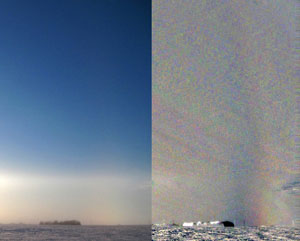An intensely cold morn, a low sun, air thick and tingling with diamond dust ice crystals, blindingly bright sundogs. That is the time to search for one of the most elusive of the halos ~ 44� parhelia or sundogs. Look twice as far from the sun as the familiar sundogs for faint prismatic brightenings of the parhelic circle. They were photographed during the great Saskatoon display of 1970 and next in January 2004 in Minnesota.
The challenge is to distinguish them with any certainty from the 46� halo which crosses the parhelic circle just two degrees further from the sun. Diamond dust swarms can hug the horizon and brighten the 46� halo there to make it appear like a sundog. Supralateral and infralateral arcs also cross the parhelic circle at 46�+ from the sun.
Camera lenses have too many distortions to allow the sun distance to be accurately measured unless they are individually and laboriously calibrated on a star field. A safer way is to measure the distance of the suspect parhelion from an estimate of where the 46� halo would cross the parhelic circle. Of course, that requires a 46� halo distinguished with certitude from a supralateral arc!
Most halos are formed by sun rays that have encountered an ice crystal only once. 44� parhelia are the exception. Some rays deviated by a plate crystal encounter a second plate and are deviated further. Double scattering requires very dense plate crystal swarms and these also produce very bright 22� sundogs.
The topmost image (1) when enhanced (mouse over the button) shows colours at and below the parhelic circle apparently sunwards of the faint 46� halo. Image (2) is a similar enhancement. Was the upper halo a 46� or supralateral? Images (3), (5) and (6) have only a weak upper tangent arc suggesting a low concentration of horizontal column crystals and therefore only a weak or nonexistent supralateral arc.
Other images leftwards of the sun show a second possible 44� parhelion. However, both the '44°' coloured regions are brightest below the altitude of the sun and could be merely intense segments of the 46� halo or infralateral arcs. The 44� parhelion identification is unfortunately rather uncertain.
More was going on. Branching upwards and outwards from the intensely bright 22� sundogs there are traces of rare Lowitz arcs � images (3) (4) and (5). Image (7) is intriguing. It might show Lowitz arc �pillars� extending downwards from the sundogs. On the other hand, plate crystals wobbling 3-4� (std dev.) from horizontal also produce a pillar like effect as in the HaloSim ray tracing comparison (8).
Photos (all copyright the photographer):
Karalee Coleman - (1),(2)
Ralph Dowson - (6)
Colin Hamlyn - (3),(5),(7)
Hearty thanks to Alan Clark of University of Calgary for collecting the images and his analysis.
|




